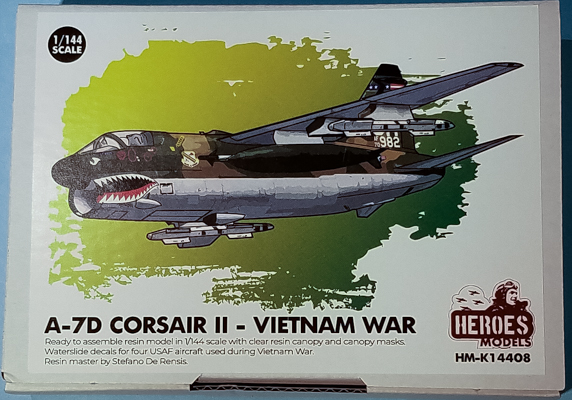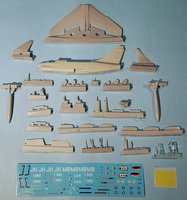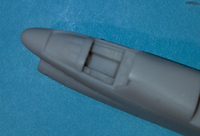
Heroes Models 1/144 A-7D Corsair II - Vietnam War
By Matt Bittner
Introduction
From Wikipedia:
"Initially adopted by USN, the A-7 proved attractive to other services, soon being adopted by the United States Air Force (USAF) and the Air National Guard (ANG) to replace their aging Douglas A-1 Skyraider and North American F-100 Super Sabre fleets. Improved models of the A-7 would be developed, typically adopting more powerful engines and increasingly capable avionics. American A-7s would be used in various major conflicts, including the Invasion of Grenada, Operation El Dorado Canyon, and the Gulf War. The type was also used to support the development of the Lockheed F-117 Nighthawk."
The Kit
The Heroes Models 1/144 A-7D Corsair II consists of 41 pieces of gray resin, two pieces of clear resin (separate canopy and windscreen), a set of masks for the canopy, and decals for four A-7Ds:
- LTV A-7D 710309, 3rd Tactical Fighter Squadron, Korat, 1975
- LTV A-7D 700982, 3rd Tactical Fighter Squadron, Korat, 1975
- LTV A-7D 699241, 354th Tactical Fighter Wing, Korat, 1972
- LTV A-7D 710354, 354th Tactical Fighter Wing, Korat, 1972
Decals appear to be in register and are nicely printed. All schemes are in typical South East Asia Colors (SEAC). Note that while the kit contains external fuel tanks, it does not come with any other external stores. However, Heroes Models do sell those separately.

|
Construction steps are different than most other instructions. It has the following seven main areas: Fuselage Assembly; Cockpit Assembly; Wings Assembly; Main Landing Gear Assembly; Nose Landing Gear Assembly; Fuel Tanks Assembly; and Final Assembly.
For the Fuselage Assembly you add the horizontal tails, missile rails and - if the type calls for it - the AN/ALQ-126 ECM pod and/or the AN/AAS-3S Pave Penny pod.
There isn't much to the Cockpit Assembly, although be sure you notice the very small drawing pointing out how to paint the control column along with how the masks work with the windscreen. Although there are two ejection seats contained with the set, be sure to use the one Heroes Models points out, for the USAF version. This section of the instructions have you add the control stick, the ejection seat, the instrument panel and the windscreen.
The Wing Assembly step just has you add the weapon pylons to the underside of the wing, based on measurements provided.
The Main Landing Gear Assembly is as it sounds and shows where all those bits go. This step is probably best left until after painting and decaling, though.

|
Same goes with the Nose Landing Gear Assembly step. Leave those pieces off until as a last stage.
The Fuel Tanks Assembly step just has you glue the rear of the fuel tanks to the front.
For the Final Assembly you glue the fuel tanks to the inner most pylons, the canopy to the fuselage and the refueling "bumper" to the upper fuselage. This step also shows what masks are used on the canopy, best applied before painting.
As I already mentioned, this kit does not come with any type of ordnance, not even Sidewinders. So if you want to add any of those to this kit, then you'll need to source them yourself. As was also already mentioned, Heroes Models has you covered, except for the Sidewinders. You might want to source those from Shelf Oddity.
Conclusion
This is an excellent kit. Take a look at the detail on the close-up shot of the fuselage and you can see the detail is top notch. There is no better A-7D in 1/144 on the market, so this is definitely the "go to" kit for the Corsair II in 1/144.
Huge thanks sent to Heroes Models for the review sample.
